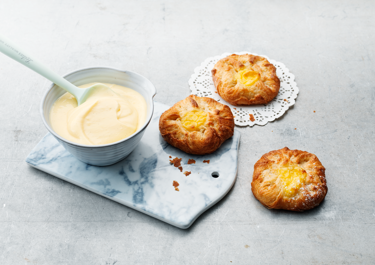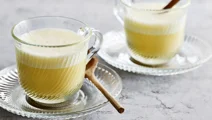Crème anglaise

Impress your family and friends with a French classic at dessert time: crème anglaise. Making your own creamy vanilla sauce is easier than you think, and the result beats anything you will find at the store.
Ingredients
|
1
Vanilla pod
|
|
|---|---|
|
600 ml
Milk
|
|
|
1¼ dl
Caster sugar
|
|
|
75 g
Corn starch
|
|
|
6
Egg yolks
|
|
|
50 g
Butter, in pieces
|
Instructions
Tip
Be careful not to overcook the creme anglaise. When you heat the mixture, be sure to whisk constantly at a low to medium heat.
Tip
Try adding different types of flavour components like orange zest. This will give the crème anglaise new and flavourful dimensions.
Crème anglaise
What is the difference between crème anglaise and custard?
Custard is the English word for any creamy vanilla sauce, thin or thick. It’s a staple in British cuisine, served as a dessert in its own right or poured on pies, cakes, and crumbles. Crème anglaise is French for ‘English cream’ which should hint that the two have a lot in common. The main difference is texture. Generally, the term crème anglaise is used for a thinner kind of pouring custard, while custard can be runny or thick depending on how it’s meant to be served.
What is crème anglaise used for?
Like custard, crème anglaise is a versatile companion in the kitchen. It can be served with fruit or on the side with pies, cakes, and crumbles. It is also used as a base for crème brûlée, vanilla ice cream, and with poached meringue in the classic French floating islands dessert.
What does crème anglaise taste like?
Crème anglaise is best described as a rich, creamy vanilla sauce. The flavour and texture can be similar melted vanilla ice cream, but usually not quite as sweet.
Is crème anglaise served hot or cold?
Part of the versatility of crème anglaise is that you can serve it either hot or cold, depending on the role it plays on your table. The chilled sauce can be served as a quick yet refined dessert with fruit, berries, and crisp topping. Or it can be gently heated to serve as the perfect accompaniment to a slice of fruit pie.
Crème anglaise – instead of custard in cakes and pastries
No matter what you call it, a sweet and creamy vanilla sauce is often the finishing touch that elevates a dessert, pastry, or cake. Crème anglaise can be thought of as a thin pouring custard, eaten as a dessert or poured on berries and pies. Our version is a bit thicker, bringing it closer to a crème pâtissière, or pastry cream. This makes it ideal for spreading between cake layers or for piping into pastries. And as fancy as it sounds, this crème anglaise is quick and easy to make.
Why homemade vanilla crème anglaise is the best
Store-bought custard or powder mix can be a welcome shortcut in the kitchen. But they will never beat the flavour and texture of a crème anglaise, made from scratch and fresh from the hob. By sourcing your own ingredients and making the cream yourself, you get full control and can ensure that flavour and texture are just right. The whole process only takes marginally longer than working with a powder mix. And of course, nothing beats the feeling of serving a silky-smooth crème anglaise with the words “I made this myself.”
How to store vanilla crème anglaise
If you have leftover crème anglaise, or if you made a batch in advance, simply pop it in the fridge in an airtight container. It should keep for up to five days. If you want to serve the crème warm, reheat it gently over low heat in a saucepan, stirring continuously to make sure that the egg yolks do not curdle.








